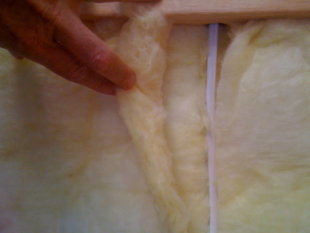
This is properly-installed insulation, sealed around a wire. Photo by Carl Seville.
By Carl Seville, Networx
There is no free insulation lunch. Super-magic foil insulation won't do what salespeople say it will. Natural, recycled, and green insulation won't work if it isn't installed right. And no insulation will make your house more efficient if air leaks around it and it isn't installed properly. As a green building consultant, I see all the mistakes that people make with insulation in the name of being "green". There's a lot of myths out there, and I'm about to dispel them. I hope I'll be able to cut through the greenwashing so that you don't get ripped off.
Myth #1: I should install as much insulation as possible to make my house more efficient and comfortable.
If you don't stop air from moving through the insulation, adding extra is pretty much a waste of effort. Fiberglass and cellulose don't stop air movement, and when air moves through insulation, it doesn't work like it's supposed to.
There must be an air barrier in complete contact with the insulation on all sides in walls, on the bottom in the attic, and on the top in a crawlspace. You also have to fill all the holes around windows, doors, pipes, wires, attic access panels, and especially soffits and dropped ceilings before adding insulation. Insulation must be installed properly with no gaps or compressed sections, and it has to be trimmed to fit closely around all pipes, wires and other obstructions.
In all climates, lots of attic insulation is good. If you live in a cold climate like Minneapolis, floor or basement wall insulation is also a good thing. Wall insulation is less important in moderate climates, especially if you're trying to install it in existing walls.
ENERGY STAR's air sealing guide and insulation recommendations are good no-nonsense resources, and I recommend that you read them.
Myth #2: I should always pick recycled or green insulation for my house.
Recycled, formaldehyde free, soy based foam, and other "green" insulation products may make you feel better, but they won't save energy or make your house healthier if they aren't installed right. It has to be installed to the proper thickness, with no gaps or compressions and in contact with the air barrier to work properly. Batts are very difficult to install properly, blown-in products like fiberglass, cellulose, and foam fill up spaces better and leave fewer gaps.
Bottom line: Even if you are using cotton batts made from recycled blue jeans or wool sheared free-range off New Zealand sheep, if it isn't installed properly, it won't help.
Myth #3: Reflective insulation works better than the regular stuff.
There are lots of people making wild claims about foil and bubble wrap insulation. These people tend to ignore the laws of physics and thermodynamics. They claim that ½" foil faced bubble wrap works as well as R-19 fiberglass. They are lying.
In certain specific situations, using a foil radiant barrier can reduce the amount of heat getting into a house. They work in attics, but they don't do much in walls. There is a lot of radiant heat in attics (ever been in yours in July?), but walls don't get as much direct sunlight, so the silver stuff doesn't do much good.
Carl Seville blogs on The Green Building Curgmudgeon and on Networx. Read more articles like this on Networx.
The following list summarizes work tasks commonly performed during Basement Wall Insulation. These tasks help ensure proper completion of the rigid insulation work and compliance with common manufacturer and vendor warranty requirements. Make sure that either you or your service provider takes responsibility for each of these tasks. All service provider task responsiblities should be clearly called out in the written contract or work orders.
ReplyDeleteWallboard laminates
Wall board laminates